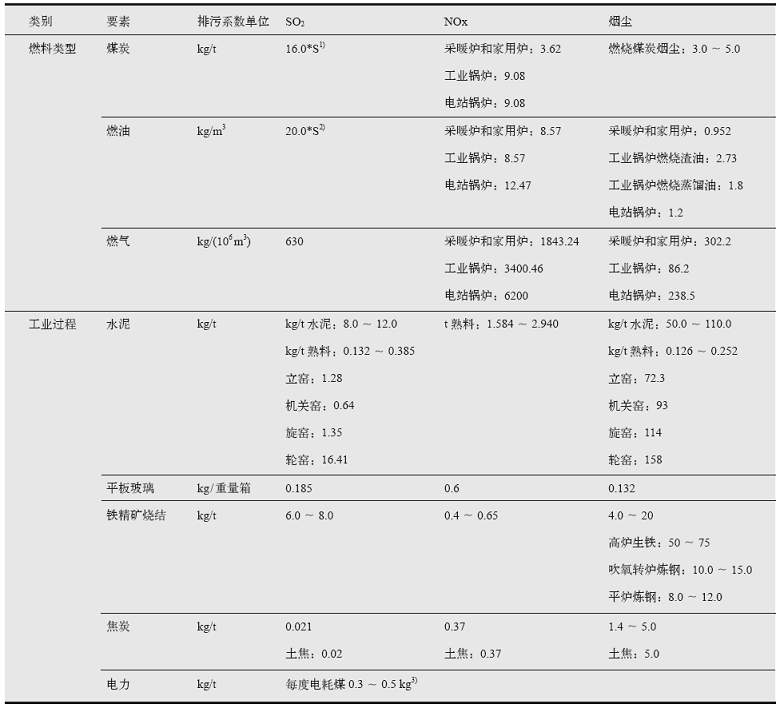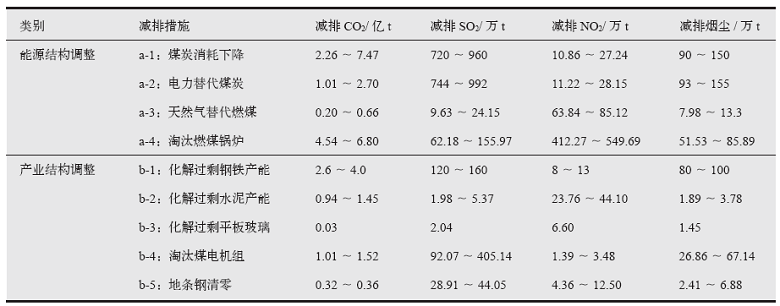Climate Change Research ›› 2021, Vol. 17 ›› Issue (3): 268-278.doi: 10.12006/j.issn.1673-1719.2020.206
• Pollutants and GHGs reduction synergy to enhance efficiency • Previous Articles Next Articles
The synergy effect assessment method and its application for air pollutants and greenhouse gases reduction
GAO Qing-Xian1( ), GAO Wen-Ou2, MA Zhan-Yun1(
), GAO Wen-Ou2, MA Zhan-Yun1( ), TANG Jia-Jie3, FU Jia-Feng1, LI Ying-Xin1, REN Jia-Xue4
), TANG Jia-Jie3, FU Jia-Feng1, LI Ying-Xin1, REN Jia-Xue4
- 1 Chinese Research Academy of Environmental Sciences, Beijing 100012, China
2 Beijing Zhongchuang Carbon Investment Education Company, Beijing 100007, China
3 Lanzhou Central Meteorological Observatory, Lanzhou 730020, China
4 Department of Resource Environment and Tourism, Capital Normal University, Beijing 100048, China
-
Received:2020-09-08Revised:2020-10-30Online:2021-05-30Published:2021-06-01 -
Contact:MA Zhan-Yun E-mail:gaoqx@craes.org.cn;mazy@craes.org.cn
Cite this article
GAO Qing-Xian, GAO Wen-Ou, MA Zhan-Yun, TANG Jia-Jie, FU Jia-Feng, LI Ying-Xin, REN Jia-Xue. The synergy effect assessment method and its application for air pollutants and greenhouse gases reduction[J]. Climate Change Research, 2021, 17(3): 268-278.
share this article
Add to citation manager EndNote|Ris|BibTeX
URL: http://www.climatechange.cn/EN/10.12006/j.issn.1673-1719.2020.206
| [1] | 田春秀, 李丽平, 胡涛, 等. 气候变化与环保政策的协同效应[J]. 环境保护, 2009,42(2):67-68. DOI: 10.3969/j.issn.0253-9705.2009.12.025. |
| Tian C X, Li L P, Hu T, et al. Synergies between climate change and environmental protection policies[J]. Environmental Protection, 2009,42(2):67-68. DOI: 10.3969/j.issn.0253-9705.2009.12.025 (in Chinese) | |
| [2] | Tollefsen P, Rypdal K, Torvanger A. Air pollution policies in Europe: efficiency gains from integrating climate effects with damage costs to health and crops[J]. Environmental Science & Policy, 2009,12:870-881 |
| [3] | 胡涛, 田春秀, 李丽平. 协同效应对中国气候变化的政策影响[J]. 环境保护, 2004,9:56-58. DOI: 10.3969/j.issn.0253-9705.2004.09.015. |
| Hu T, Tian C X, Li L P. Influence of co-benefit on policy in China[J]. Environmental Protection, 2004,9:56-58. DOI: 10.3969/j.issn.0253-9705. 2004.09.015 (in Chinese) | |
| [4] | 胡涛, 田春秀, 毛显强. 协同控制:回顾与展望[J]. 环境与可持续发展, 2012,1:25-29. DOI: 10.3969/j.issn.1673-288X.2012.01.006. |
| Hu T, Tian C X, Mao X Q. Co-control: lookback and look forward[J]. Environment and Sustainable Development, 2012,1:25-29. DOI: 10.3969/j.issn.1673-288X.2012.01.006 (in Chinese) | |
| [5] | 薛冰, 任婉侠, 马志孝, 等. 应对气候变化的协同效应研究综述[J]. 阅江学刊, 2013,2:30-35. DOI: CNKI:SUN:YJXK.0.2013-02-008. |
| Xue B, Ren W X, Ma Z X, et al. A review of co-benefits in climate change researches[J]. Yuejiang Academic Journal, 2013,2:30-35. DOI: CNKI:SUN:YJXK.0.2013-02-008 (in Chinese) | |
| [6] | 薛冰. 空气污染物与温室气体的协同防控[J]. 改革, 2017,282(8):78-80. DOI: CNKI:SUN:REFO.0.2017-08-023. |
| Xue B. Coordinated prevention and control of air pollutants and greenhouse gases[J]. Reform, 2017,282(8):78-80. DOI: CNKI:SUN:REFO.0.2017-08-023 (in Chinese) | |
| [7] |
Longo A, Hoyos D, Markandya A. Willness to pay for ancillary benefits of climate change mitigation[J]. Environmental Resource Economic, 2012,51:119-140
doi: 10.1007/s10640-011-9491-9 URL |
| [8] | Chae Y. Co-benefit analysis of an air quality management plan and greenhouse gas reduction strategies in the Seoul metropolitan area[J]. Environmental Science & Policy, 2010,13:205-216 |
| [9] | 周颖, 刘兰翠, 曹东. 二氧化碳和常规污染物协同减排研究[J]. 热力发电, 2013,42(9):63-65. DOI: 10.3969/j.issn.1002-3364.2013.09.063. |
| Zhou Y, Liu L C, Cao D. Synergistical emission control of carbon dioxide and conventional pollutants in thermal power plants[J]. Thermal Power Generation, 2013,42(9):63-65. DOI: 10.3969/j.issn.1002-3364.2013.09.063 (in Chinese) | |
| [10] | 毛显强, 曾桉, 刘胜强, 等. 钢铁行业技术减排措施硫、氮、碳协同控制效应评价研究[J]. 环境科学学报, 2012,32(5) : 1253-1260. DOI: CNKI:SUN:HJXX.0.2012-05-033. |
| Mao X Q, Zeng A, Liu S Q, et al. Assessment of SO2, NOx and CO2 co-control effects by technological reduction measures in iron & steel industry[J]. Acta Scientiae Circumstantiae, 2012,32(5):1253-1260. DOI: CNKI:SUN: HJXX.0.2012-05-033 (in Chinese) | |
| [11] | 薛婕, 罗宏, 吕连宏, 等. 中国主要大气污染物和温室气体的排放特征与关联性[J]. 资源科学, 2012,34(8):1452-1460. DOI: 1007-7588(2012)08-1452-09. |
| Xue J, Luo H, Lyu L H, et al. Emission characteristics and correlation of main air pollutant and greenhouse gas in China[J]. Resources Science, 2012,34(8):1452-1460. DOI: 1007-7588(2012)08-1452-09 (in Chinese) | |
| [12] | 周颖, 张宏伟, 蔡博峰, 等. 水泥行业常规污染物和二氧化碳协同减排研究[J]. 环境科学与技术, 2013,36(12):164-168. DOI: 10.3969/j.issn.1003-6504.2013.12.033. |
| Zhou Y, Zhang H W, Cai B F, et al. Synergistic reduction of local pollutants and CO2 from cement industry[J]. Environmental Science and Technology, 2013,36(12):164-168. DOI: 10.3969/j.issn.1003-6504.2013.12.033 (in Chinese) | |
| [13] | 顾阿伦, 滕飞, 冯相昭. 主要部门污染物控制政策的温室气体协同效果分析与评价[J]. 中国人口?资源与环境, 2016,26(2):10-17. DOI: 10.3969 / j.issn.1002-2104.2016.02.002. |
| Gu A L, Teng F, Feng X Z. Assessment and analysis on co-benefits of pollution control and greenhouse gases emission reduction in key sectors[J]. China Population, Resources and Environment, 2016,26(2):10-17. DOI: 10.3969/j.issn. 1002-2104.2016.02.002 (in Chinese) | |
| [14] | 萧谦, 刘宁. 城市温室气体与大气污染控制协同效应研究[J]. 工程管理, 2012,9:59-61. DOI: CNKI:SUN:KJXY.0.2012-09-025. |
| Xiao Q, Liu N. Research on the synergistic effect of urban greenhouse gas and air pollution control[J]. Journal of Engineering Management, 2012,9:59-61. DOI: CNKI:SUN:KJXY.0.2012-09-025 (in Chinese) | |
| [15] | 傅京燕, 刘佳鑫. 气候变化政策的协同收益研究述评[J]. 环境经济研究, 2018,2:134-148. DOI: 10.19511/j.cnki.jee.2018.02.009. |
| Fu J Y, Liu J X. Reviews of the cooperative benefits of climate change policy[J]. Journal of Environmental Economics, 2018,2:134-148. DOI: 10.19511/j.cnki.jee.2018.02.009 (in Chinese) | |
| [16] | Vuurena D P, Cofala J, Eerens H E, et al. Exploring the ancillary benefits of the Kyoto Protocol for air pollution in Europe[J]. Energy Policies, 2006,34:444-460 |
| [17] | 李丽平, 周国梅, 季浩宇. 污染减排的协同效应评价研究: 以攀枝花市为例[J]. 中国人口?资源与环境, 2010,20(5):91-95. |
| Li L P, Zhou G M, Ji H Y. Research on synergy evaluation of pollution reduction: taking Panzhihua city as an example[J]. China Population, Resources and Environment, 2010,20(5):91-95 (in Chinese) | |
| [18] | 庞军, 石媛昌, 冯相昭, 等. 实施低碳水泥标准的影响及协同减排效果分析[J]. 气候变化研究进展, 2013,9(4):275-283. DOI: 10.3969/j.issn.1673-1719.2013.04.006. |
| Pang J, Shi Y C, Feng X Z, et al. Analysis on impacts and co-abatement effects of implementing the low-carbon cement standard[J]. Climate Change Research, 2013,9(4):275-283. DOI: 10.3969/j.issn.1673-1719.2013.04.006 (in Chinese) | |
| [19] | 毛显强, 曾桉, 胡涛, 等. 技术减排措施协同控制效应评价研究[J]. 中国人口?资源与环境, 2011,21(12):1-7. DOI: 10.3969/j.issn.1002-2104.2011.12.001. |
| Mao X Q, Zeng A, Hu T, et al. Study of coordinate control effect assessment of technical measures for emission reduction[J]. China Population, Resources and Environment, 2011,21(12):1-7. DOI: 10.3969/j.issn.1002-2104.2011.12.001 (in Chinese) | |
| [20] | 孙庆贺, 陆永琪, 傅立新, 等. 我国氮氧化物排放因子的修正和排放量计算: 2000年[J]. 环境工程学报, 2004 (2):90-94. DOI: 10.3969/j.issn.1673-9108.2004.02.023. |
| Sun Q H, Lu Y Q, Fu L X, et al. Adjustment on NOx emission factors and calculation of NOx emissions in China in the year 2000[J]. Techniques and Equipment for Environmental Pollution Control, 2004 (2):90-94. DOI: 10.3969/j.issn.1673-9108.2004.02.023 (in Chinese) | |
| [21] | 汪澜. 水泥生产企业CO2排放量的计算[J]. 中国水泥, 2009,90(11):21-22. |
| Wang L. Calculation of carbon dioxide emission of cement production enterprises[J]. China Cement, 2009,90(11):21-22 (in Chinese) | |
| [22] | 中国建筑材料科学研究总院. 3111水泥制造行业产排污系数表 [EB/OL]. 2012 [2020-09-08]. https://wenku.baidu.com/view/995bb0 82b9d528ea81c77913.html. |
| China Building Materials Academy. Table of pollutant emission factor for cement manufacturing industry[EB/OL]. 2012 [2020-09-08]. https://wenku.baidu.com/view/995bb0 82b9d528ea81c77913.html.(in Chinese) | |
| [23] | 肖俊清, 陆少锋. 平板玻璃行业大气污染物排放源强核算方法研究[J]. 中国玻璃, 2017,4:21-23. |
| Xiao J Q, Lu S F. Study on intensity accounting method for air pollutant emission source in flat glass industry[J]. China Glass, 2017,4:21-23 (in Chinese) | |
| [24] | 钟悦之, 宋晓晖, 王彦超, 等. 中国平板玻璃行业大气污染物排放特征研究[J]. 中国环境科学, 2018,38(12):4451-4459. DOI: 10.3969/j.issn.1000-6923.2018.12.007. |
| Zhong Y Z, Song X H, Wang Y C, et al. Emission characteristics from flat-glass industry in China[J]. China Environmental Science, 2018,38(12):4451-4459. DOI: 10.3969/j.issn.1000-6923.2018.12.007 (in Chinese) | |
| [25] | 朱法华, 钟鲁文, 王强. 火电行业主要污染物产排污系数[M]. 北京: 中国环境科学出版社, 2009. |
| Zhu F H, Zhong L W, Wang Q. Emission coefficient of main pollutants in thermal power industry [M]. Beijing: China Environmental Press, 2009 (in Chinese) | |
| [26] | 国家发展改革委气候司能源研究所. 省级温室气体清单指南: 试行[EB/OL]. 2013 [2020-09-08] https://wenku.baidu.com/view/7ae95325f111f18583d05a67.html. |
| Energy Research Institute of Climate Department of National Development and Reform Commission, People's Republic of China. Guidelines for provincial greenhouse gas inventories [EB/OL]. 2013 [2020-09-08]. https://wenku.baidu.com/view/7ae95325f111f18583d05a67.html. (in Chinese) | |
| [27] | 胡名操. 环境保护实用数据手册[M]. 北京: 机械工业出版社, 1990. |
| Hu M C. Practical data manual for environmental protection [M]. Beijing: China Machine Press, 1990 (in Chinese) | |
| [28] | 国家市场监督管理总局, 国家标准化管理委员会. 综合能耗计算通则: GB/T 2589—2008 [S/OL]. 2019 [2020-09-08]. https://wenku.baidu.com/view/36689c0fd1d233d4b14e852458fb770bf68a3bd2.html. |
| State Administration for Market Regulation, Standardization Administration. General rules for calculation of comprehensive energy consumption: GB/T 2589-2008[S]. 2019 [2020-09-08]. https://wenku.baidu.com/view/36689c0fd1d233d4b14e852458fb770bf68a3bd2.html. | |
| [29] | 中华人民共和国国家发展和改革委员会. 发改委、建设部等紧急通知打击地条钢非法产销行为[J]. 经济管理文摘, 2004 (13):6-7. |
| National Development and Reform Commission, People's Republic of China. The National Development and Reform Commission, the Ministry of Construction, etc. urgently notify the illegal production and sale of land steel[J]. Economy and Management Digest, 2004 (13):6-7 (in Chinese) | |
| [30] | IPCC. 2006 IPCC guidelines for national greenhouse gas inventories [M/OL]. 2006 [2020-09-08]. https://www.ipcc-nggip.iges.or.jp/public/2006gl/index.html. |
| Viewed | ||||||
|
Full text |
|
|||||
|
Abstract |
|
|||||




